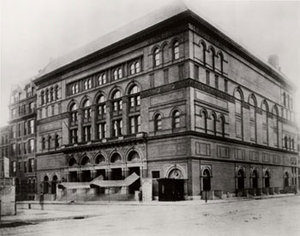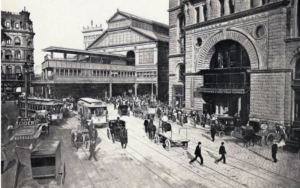I’ve been sitting on some thoughts for a week now from class discussion on 4/15 revolving around how the stage can be used in different ways. I am always fascinated by the ability that staged performances have to convey messages in an intimate way. The structure of a play itself is potentially limitless, but in a traditional setting we expect to go to watch other people give a performance of sorts, independent of the audience itself. For me, why would I go to a play instead of viewing a movie? After all, a movie truly acts independently of the audience! Perhaps its authenticity? Living in the moment? For me, the power of the staged play is its ability to interact, perhaps against the original desire of the audience members. The reality that living people are looking at the audience makes theatre potentially unsettling for the audience, but as Parks says in The America Play and Other Works in the section From Elements of Style, “Why does this thing I’m writing have to be a play?” (7). The intentional of choice to write a play for the artists creation should effectively make use of the unique tools in the toolbox of the theatre, namely personal connections to the audience (despite audience members still not expecting this!) Continue reading “WHY write a play? (Capitalization intended!)”
What Wall Are You On?
Leaving home and being forced to play the game of college, I have noticed a lot about my peers and the campus as a whole. The other day, I was having a friendly discussion about the role media plays on our lives; it shapes us to be the perfect mold society wants us to be, based on a course available here, Comn 215, Mass Media and Society. Not only are our physical appearances molded, but our attitudes, actions, and reactions are shaped. I personally think I as an individual am being shaped by media, no matter how hard I resist it. A simple example: I watch HGTV a lot… like I am obsessed with it. More recently, I have been watching Queer Eye– if you don’t know what this show is, hit up Netflix after reading my blog post. Basically, Queer Eye is meant to teach an individual how to present themselves, how to become a member of society, how to design their home, and how to have a healthy lifestyle. Personally, these shows have shown me how to design my home, and of course, I listen because it seems to be the “best” way out there. Although Queer Eye is a positive way to get someone who is essentially “lost in life” back on the right track, they are pushing social norms onto them. They are telling the individual what is appropriate to fit into society, while also telling them to be their “true self”. How is someone supposed to be made over from the inside out, and still expected to be themselves? The individuals on the show are essentially being altered to fit into society instead of being an outcast, but at the same time, they are building their self-confidence and overall feeling of self-worth, which is definitely a positive. Where is the line of building self-confidence but changing who you are to be more accepted? They push the individual to be their “true self” but change everything about them to fit in. I haven’t truly figured it out yet…not sure if I ever will…
Go Against The Grain
After scrolling through blog posts in hopes to find some inspiration to write, I came across Mikhayla‘s, where she mentioned the quote, “the last thing American theatre needs is another lame play” which came from Suzan-Lori Parks’, The American Play. Mikhalya mentioned how in her high school English classes, for the theatre portion of the class, she “did the stereotypical thing and read a Shakespeare play for every year of high school.“ I can definitely relate to Mikhayla because I became frustrated with constantly reading Shakespeare and never getting any exposure to any other writers. Since I want to be a teacher in the future, I want to make sure to provide my students with several types of texts from different writers so, they are not left with a single story.
Looking for Empathy
The following are some common examples of excuses I have heard or seen for being a casual observer of racism and other discrimination: as a person who has never experienced slavery, I don’t have the emotional range to sympathize with enslaved people or even their descendants. I will never be prejudiced against in ways that they have experienced their entire lives, so how can I possibly relate? Oh, that was a long time ago. I don’t care because I don’t know… Continue reading “Looking for Empathy”
Straying Away from Tradition
In today’s society, we tend to stray away from thinking deeply about the food we eat in terms of where it comes from. Personally, I only think about what I am eating when I have heard negative reviews on the place I am eating from or how the food looks. It is even more rare that I consider how the food was processed in terms of hunting and how it was grown. I asked some of my friends how often they think about the food they eat and where it comes from. They explained to me how it’s rare that they think about where their food is coming from because eating is part of a daily routine. I agree with their responses for the most part because on a day to day basis, I am focusing more on making sure I eat throughout the day, not necessarily stressing what I am eating. Continue reading “Straying Away from Tradition”
Seeing Sound Waves (and More)
Last semester, I worked as an undergraduate lab instructor in the physics department for Dr. McLean’s “The Science of Sound” course. I thoroughly enjoyed working in this position and feel that I learned a great deal from it, not only about the science of sound but about myself, as well. While working as a lab instructor for this lab granted me new skills and a passion for instructing, it also, unexpectedly, left me with tools I can now use to enrich my interpretations of Steve Prince’s art.
For example, when I look at Prince’s piece, “Requiem for Brother John,” I am instantly drawn to what I perceive to be sound waves emanating from the trumpet in the background. These waves remind me of my time spent working in the Science of Sound Lab and of the hours I spent grading students’ drawn representations of waves for accuracy (not artistry, though some of the waves were drawn with obvious skill and flair). Notably, the waves appear curved upon their immediate exit from the trumpet and then straighten out when they reach the left-hand corner of work, as waves do upon propagating far enough out.
Everything Comes from the Fractal
Everything comes from the fractal. It’s a notion that didn’t come to me until recently, but after the heating plant visit, the group blog posts and several individual posts I have reached the conclusion that African Fractals and the ideas discussed in it is a perfect reflection of everything we have discussed in class thus far. I am fully aware of how bold and vague this statement sounds, but allow me to unpack here. Continue reading “Everything Comes from the Fractal”
Spirituals and the Nationalistic Music of the United States
Spirituals and the Nationalistic Music of The United States

Alongside the early stages of the development of Western music in the Americas during the late 1800s came the global desire to establish national boundaries; music was one particular area where countries wanted to display their national pride and establish their nationality. The Americas, particularly the United States, was at an awkward stage in the development of its own nationalistic music, as it was not clearly established what “American music” was at this point. Eventually, a composer from Prague alongside the National Conservatory of Music, founded by Jeannette Meyers Thurber, in the United States would help push the majority of the country see that “American music” was to be built off the country’s foundation: the music and rhythms of the indigenous people and African Americans—this American music consists of the African American spirituals that WEB DuBois discussed in The Souls of Black Folk; this post serves to give some more context around the spirituals that emerged from traditional African songs that were passed down from the very first slaves in the U.S.

By the late 19th century, when the United States was trying to establish its own music, European music had already been established in the several countries, making the creation of their nationalistic music simple and original. American music, however, was in its early stages of development, leaving the people of the United States reliant on the more established European classical music (Grout, 2019). The study of music was also extremely dependent on European music; people from the United States started traveling to Europe in order to study music there—after placing European music at the center of music, many people then tried to imitate this music and during the era where national boundaries were rising attempted label it as America’s nationalistic music, in spite of the music that already existed in the United States. Continue reading “Spirituals and the Nationalistic Music of the United States”
Who’s Your Audience?
Upon learning that Mark Broomfield was attending one of our classes, I was excited because of my personal connection to dance. I have been dancing for years now and since being a student at Geneseo have not had a chance to take one of his classes yet; therefore, I was anxious to see what he would teach us and how it would connect to Steve Prince’s art. We spent this class period moving around which is expected, but something one of my peers brought up inspired me to think about our everyday comfortability. In discussing the stereotypical feminine and masculine dance phrases/poses, Dr. Broomfield challenged us to push against these stereotypes. In order to accomplish this my group decided that half of us would repeat the same sequence of the stereotyped feminine and masculine moves, and the other half would mirror the same moves but modify them to fit the other gender. The point of this exercise for me meant fighting stereotypes and becoming comfortable with being uncomfortable. Continue reading “Who’s Your Audience?”
The Audience’s Role in Theater
In class on Tuesday, we read the beginning of Susan-Lori Parks’ play, Imperceptible Mutabilities. Parks sets up a situation that forces the audience to think about their role as observers in theater, literature, or other forms of art. Mona, Chona, and Verona are watching Wild Kingdom which is a documentary series where the host “Marlin Perkins explores various animals in their natural habitats.” The naturalist/Dr. Lutsky is observing them as they watch Perkins. We are then witnessing all of these interactions on the page (or on stage). In my reading of this play, Parks is commenting on the relationship between the viewer and the performer and the inevitable involvement of the audience in the show simply by having seen it.

